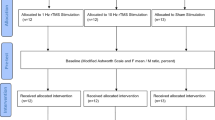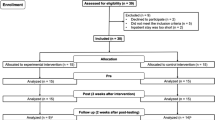Abstract
Objective
Repetitive Transcranial Magnetic Stimulation (rTMS) has been used to treat post-stroke upper limb spasticity (ULS) in addition to physiotherapy (PT). To determine whether rTMS associated with PT modulates cortical and spinal cord excitability as well as decreases ULS of post-stroke patients.
Methods
Twenty chronic patients were randomly assigned to either the intervention group-1 Hz rTMS on the unaffected hemisphere and PT, or control group-sham stimulation and PT, for ten sessions. Before and after sessions, ULS was measured using the modified Ashworth scale and cortical excitability using the output intensity of the magnetic stimulator (MSO). The spinal excitability was measured by the Hmax/Mmax ratio of the median nerve at baseline, at the end of treatment, and at the 4-week follow-up.
Results
The experimental group showed at the end of treatment an enhancement of cortical excitability, i.e., lower values of MSO, compared to control group (p = 0.044) and to baseline (p = 0.028). The experimental group showed a decreased spinal cord excitability at the 4-week follow-up compared to control group (p = 0.021). ULS decreased by the sixth session in the experimental group (p < 0.05).
Conclusion
One-hertz rTMS associated with PT increased the unaffected hemisphere excitability, decreased spinal excitability, and reduced post-stroke ULS.




Similar content being viewed by others
Abbreviations
- rTMS:
-
repetitive transcranial magnetic stimulation
- ULS:
-
upper limb spasticity
- PT:
-
physical therapy
- MSO:
-
magnetic stimulator output
- CT:
-
computed tomography
- MRI:
-
magnetic resonance imaging
- MAS:
-
modified ashworth scale
- MEP:
-
motor-evoked potential
- MT:
-
motor threshold
- EMG:
-
electromyography
- H-reflex:
-
Hoffmann reflex
- Hmax:
-
maximum amplitude of the H-wave
- Mmax:
-
maximum amplitude of the M-wave
- FDI:
-
first dorsal interosseous
- RCT:
-
randomized clinical trial
- SPSS:
-
statistical package for social sciences
References
Harris JE, Eng JJ (2007) Paretic upper-limb strength best explains arm activity in people with stroke. Phys Ther 87(1):88–97
Cousins E, Ward AB, Roffe C, Rimington LD, Pandyan AD (2009) Quantitative measurement of poststroke spasticity and response to treatment with botulinum toxin: a 2-patient case report. Phys Ther 89(7):688–697
Burke D, Wissel J, Donnan GA (2013) Pathophysiology of spasticity in stroke. Neurology 80(3 Supplement 2):S20–S26
Barnes MP, Johnson GR (2008) Upper motor neurone syndrome and spasticity: clinical management and neurophysiology. Cambridge University Press
Gracies JM (2005) Pathophysiology of spastic paresis. II: emergence of muscle overactivity. Muscle Nerve 31(5):552–571
Priori AF, Cogiamanian F, Mrakic-Sposta S (2006) Pathophysiology of spasticity. Neurol Sci 27(4):307–309
Valero-Cabre A, Pascual-Leone A (2005) Impact of TMS on the primary motor cortex and associated spinal systems. IEEE Eng Med Biol Mag 24(1):29–35
Valle AC, Dionisio K, Pitskel NB, Pascual-Leone A, Orsati F, Ferreira MJ, Boggio PS, Lima MC, Rigonatti SP, Fregni F (2007) Low and high frequency repetitive transcranial magnetic stimulation for the treatment of spasticity. Dev Med Child Neurol 49(7):534–538
Goldstein EM (2001) Spasticity management: an overview. J Child Neurol 16(1):16–23
FAS V (1997) Alterações Centrais e Periféricas Após Lesão do Sistema Nervoso Central. Considerações e Implicações para a Fisioterapia. Braz J Phys Ther 2(1):19–34
Bolognini N, Vallar G, Casati C, Latif LA, El-Nazer R, Williams J, Banco E, Macea DD, Tesio L, Chessa C (2011) Neurophysiological and behavioral effects of tDCS combined with constraint-induced movement therapy in poststroke patients. Neurorehabil Neural Repair 25(9):819–829
Kakuda W, Abo M, Kobayashi K, Momosaki R, Yokoi A, Fukuda A, Ito H, Tominaga A, Umemori T, Kameda Y (2011) Anti-spastic effect of low-frequency rTMS applied with occupational therapy in post-stroke patients with upper limb hemiparesis. Brain Inj 25(5):496–502
Galvão SCB, dos Santos RBC, dos Santos PB, Cabral ME, Monte-Silva K (2014) Efficacy of coupling repetitive transcranial magnetic stimulation and physical therapy to reduce upper-limb spasticity in patients with stroke: a randomized controlled trial. Arch Phys Med Rehabil 95(2):222–229
Etoh S, Noma T, Ikeda K, Jonoshita Y, Ogata A, Matsumoto S, Shimodozono M, Kawahira K (2013) Effects of repetitive trascranial magnetic stimulation on repetitive facilitation exercises of the hemiplegic hand in chronic stroke patients. J Rehabil Med 45(9):843–847
Rose DK, Patten C, McGuirk TE, Lu X, Triggs WJ (2014) Does inhibitory repetitive transcranial magnetic stimulation augment functional task practice to improve arm recovery in chronic stroke? Stroke Res Treat 2014:305236
Rastgoo M, Naghdi S, Nakhostin Ansari N, Olyaei G, Jalaei S, Forogh B, Najari H (2016) Effects of repetitive transcranial magnetic stimulation on lower extremity spasticity and motor function in stroke patients. Disabil Rehabil 38(19):1918–1926
Naghdi S, Ansari NN, Rastgoo M, Forogh B, Jalaie S, Olyaei G (2015) A pilot study on the effects of low frequency repetitive transcranial magnetic stimulation on lower extremity spasticity and motor neuron excitability in patients after stroke. J Bodyw Mov Ther 19(4):616–623
Takeuchi N, Izumi S-I (2012) Maladaptive plasticity for motor recovery after stroke: mechanisms and approaches. Neural Plast 2012(2012):1–9
Bohannon RW, Larkin PA, Smith MB, Horton MG (1987) Relationship between static muscle strength deficits and spasticity in stroke patients with hemiparesis. Phys Ther 67(7):1068–1071
Brucki SM, Nitrini R, Caramelli P, Bertolucci PHF, Okamoto IH (2003) Sugestões para o uso do mini-exame do estado mental no Brasil. Arq Neuropsiquiatr 61:777–781
Bakheit A, Maynard V, Curnow J, Hudson N, Kodapala S (2003) The relation between Ashworth scale scores and the excitability of the α motor neurones in patients with post-stroke muscle spasticity. J Neurol Neurosurg Psychiatry 74(5):646–648
Pinelli P, Di Lorenzo G (1989) Electromyographic assessment of spasticity. In: Electromyographic assessment of spasticity. Springer
Palmieri RM, Ingersoll CD, Hoffman MA (2004) The Hoffmann reflex: methodologic considerations and applications for use in sports medicine and athletic training research. J Athl Train 39, 268(3)
Charalambous CP (2014) Interrater reliability of a modified Ashworth scale of muscle spasticity. In: Classic papers in orthopaedics. Springer, pp 415–417
Van Peppen RP, Kwakkel G, Wood-Dauphinee S, Hendriks HJ, Van der Wees PJ, Dekker J (2004) The impact of physical therapy on functional outcomes after stroke: what’s the evidence? Clin Rehabil 18(8):833–862
Takeuchi N, Chuma T, Matsuo Y, Watanabe I, Ikoma K (2005) Repetitive transcranial magnetic stimulation of contralesional primary motor cortex improves hand function after stroke. Stroke 36(12):2681–2686
Zhou Q, Tao HW, Poo MM (2003) Reversal and stabilization of synaptic modifications in a developing visual system. Science 300(5627):1953–1957
Xu L, Anwyl R, Rowan MJ (1998) Spatial exploration induces a persistent reversal of long-term potentiation in rat hippocampus. 394(6696):891
Manahan-Vaughan D, Braunewell KH (1999) Novelty acquisition is associated with induction of hippocampal long-term depresssion. Proc Natl Acad Sci U S A 96(15):8739–8744
Fricke K, Seeber AA, Thirugnanasambandam N, Paulus W, Nitsche MA, Rothwell JC (2011) Time course of the induction of homeostatic plasticity generated by repeated transcranial direct current stimulation of the human motor cortex. J Neurophysiol 105(3):1141–1149
Cosentino G, Fierro B, Paladino P, Talamanca S, Vigneri S, Palermo A, Giglia G, Brighina F (2012) Transcranial direct current stimulation preconditioning modulates the effect of high-frequency repetitive transcranial magnetic stimulation in the human motor cortex. Eur J Neurosci 35(1):119–124
Huang Y-Z, Rothwell JC, Edwards MJ, Chen R-S (2008) Effect of physiological activity on an NMDA-dependent form of cortical plasticity in human. Cereb Cortex 18(3):563–570
Bütefisch C (2006) Neurobiological bases of rehabilitation. Neurol Sci 27(1):18–23
Riecker A, Gröschel K, Ackermann H, Schnaudigel S, Kassubek J, Kastrup A (2010) The role of the unaffected hemisphere in motor recovery after stroke. Hum Brain Mapp 31(7):1017–1029
Schaechter JD, Perdue KL, Wang R (2008) Structural damage to the corticospinal tract correlates with bilateral sensorimotor cortex reorganization in stroke patients. Neuroimage 39(3):1370–1382
Lotze M, Markert J, Sauseng P, Hoppe J, Plewnia C, Gerloff C (2006) The role of multiple contralesional motor areas for complex hand movements after internal capsular lesion. J Neurosci 26(22):6096–6102
Di Pino G, Pellegrino G, Assenza G, Capone F, Ferreri F et al (2014) Modulation of brain plasticity in stroke: a novel model for neurorehabuilitation. Nat Rev Neurol 10(10):597–608
Gunduz A, Kumru H, Pascual-Leone A (2014) Outcomes in spasticity after repetitive transcranial magnetic and transcranial direct current stimulations. Neural Regen Res 9, 712(7)
Mukherjee A, Chakravarty A (2010) Spasticity mechanisms–for the clinician. Front Neurol 1
Levin MF, Hui-Chan C (1993) Are H and stretch reflexes in hemiparesis reproducible and correlated with spasticity? J Neurol 240(2):63–71
Funding
KMS is supported by CNPQ-Brazil (grant number 308291/2015-8) and the research was supported by grant (number APQ-0357-4.08/13) from Fundação de Amparo a Ciência e Tecnologia do Estado de Pernambuco (FACEPE)-Recife-Brazil.
Author information
Authors and Affiliations
Corresponding author
Ethics declarations
Conflict of interest
The authors declare that they have no conflict of interest.
Additional information
Publisher’s note
Springer Nature remains neutral with regard to jurisdictional claims in published maps and institutional affiliations.
Rights and permissions
About this article
Cite this article
dos Santos, R.B.C., Galvão, S.C.B., Frederico, L.M.P. et al. Cortical and spinal excitability changes after repetitive transcranial magnetic stimulation combined to physiotherapy in stroke spastic patients. Neurol Sci 40, 1199–1207 (2019). https://doi.org/10.1007/s10072-019-03765-y
Received:
Accepted:
Published:
Issue Date:
DOI: https://doi.org/10.1007/s10072-019-03765-y




